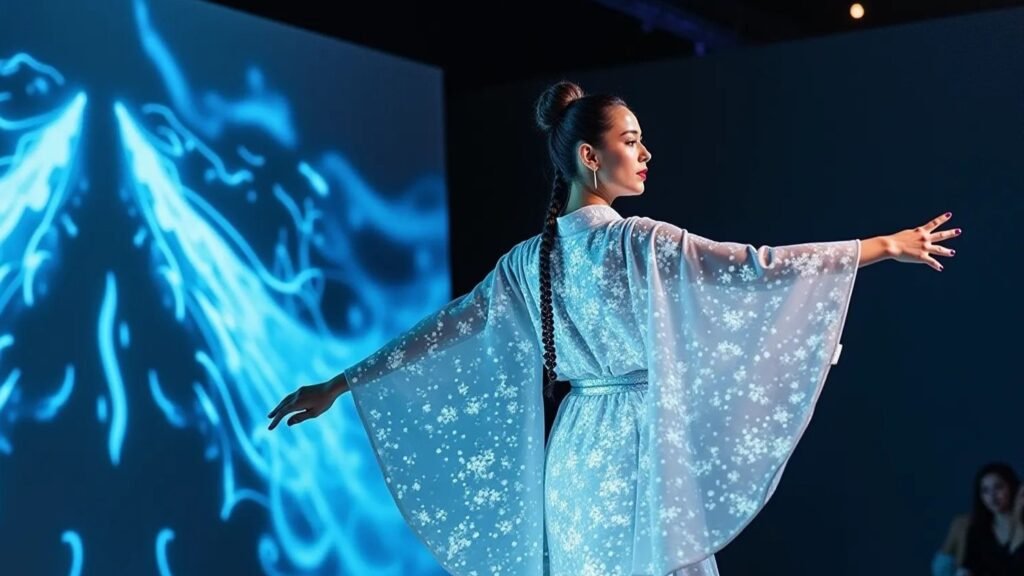Walking through Expo 2020 feels like stepping into a fever dream curated by the most ambitious futurists on the planet. I’ve spent three days wandering between pavilions that look like they were designed by architects from 2050, and my notebook is overflowing with observations that read like science fiction but are happening right now, under the desert sun.
The UAE has essentially built a temporary city that showcases what happens when unlimited budgets meet unlimited imagination. Every corner reveals another impossibility made manifest — and I’m here for all of it.
The fashion pavilion stopped me cold. Not because of the expected runway displays or designer collaborations, but because of a single exhibit: a traditional Japanese kimono woven with smart fibers that respond to the wearer’s heartbeat, projecting digital patterns that shift with emotional states. The fabric literally becomes a canvas for feelings, blooming with cherry blossoms when calm, sparking with electric blues during excitement.
Nearby, an Emirati designer demonstrated how traditional geometric patterns could be animated through augmented reality. Hold up your phone to her abaya, and suddenly the intricate arabesque designs start moving like living calligraphy, telling stories in flowing Arabic script that dissolves and reforms with each gesture.
This is what fascinates me: technology isn’t erasing cultural heritage — it’s amplifying it, giving ancient artforms new languages to speak.
Today I walked through a vertical forest growing in the middle of the desert. The Singapore pavilion has created this impossible oasis where tropical plants thrive in climate-controlled perfection, their roots drinking recycled air moisture while sensors monitor every leaf for optimal health. It’s beautiful and slightly unsettling — nature perfected through technology, or technology disguised as nature.
The juxtaposition feels intentional. Here’s humanity’s eternal challenge: how do we innovate without losing what makes us human? How do we embrace the future without abandoning our roots?
The mobility pavilion showcased autonomous flying taxis that will apparently be normal transportation within the decade. I watched a demo where passengers glided silently above traffic in glass pods that looked like something from a Miyazaki film. The technology is remarkable, but what struck me was the pilot’s explanation: “We’re not just changing how people move — we’re reimagining what connection means when distance becomes irrelevant.”
Connection. That word keeps surfacing as I navigate these pavilions. Every innovation here claims to bring people closer together, yet I find myself wondering if we’re engineering solutions to problems we’ve created through previous engineering solutions.
The Netherlands pavilion featured an AI system trained on centuries of Dutch artistic traditions — from Vermeer’s light techniques to contemporary street art. Visitors could collaborate with the algorithm to create hybrid artworks that blend human intuition with machine learning. The results were stunning: paintings that felt both timeless and impossibly contemporary.
But the most interesting part wasn’t the technology — it was watching people interact with it. Some approached cautiously, suspicious of AI’s creative capabilities. Others dove in enthusiastically, treating the algorithm like a sophisticated paintbrush. Both groups created something neither human nor machine could have achieved alone.
Every pavilion visit adds characters to my mental database. The Saudi engineer explaining how her grandmother’s traditional henna patterns inspired her solar panel designs. The Finnish architect whose meditation app uses sounds from Lapland forests to calm urban anxiety. The Brazilian artist who transforms deforestation data into haunting musical compositions.
These people are living at the intersection of tradition and innovation, using technology to preserve and transform their cultures simultaneously. They’re exactly the kinds of complex, contradictory characters my stories need — people navigating the space between who they’ve always been and who they’re becoming.
As I write this, sitting in a café that overlooks the entire Expo site, I’m struck by how this temporary city demonstrates humanity’s perpetual negotiation with progress. We build toward the future while carrying our histories with us, creating hybrid forms that honor both impulses.
The stories I’m collecting here won’t fit neatly into my nail studio collection, but they’re planting seeds for something larger. Maybe a novel about people who use technology to reconnect with traditions that seemed lost. Maybe characters who discover their authentic selves through digital transformations.
The future, it turns out, isn’t about choosing between heritage and innovation — it’s about weaving them together into patterns as complex and beautiful as those AR arabesques I watched dance across traditional fabric.
Posted from tomorrow’s city, where the past and future shake hands under endless sky.
— Writer Julia Zolotova

